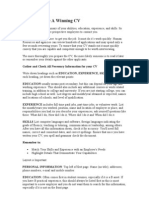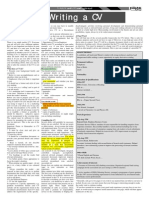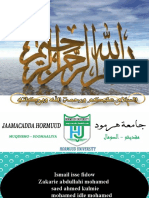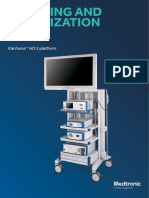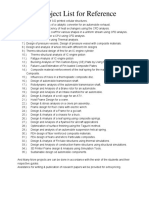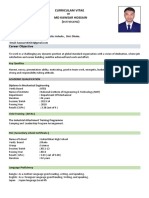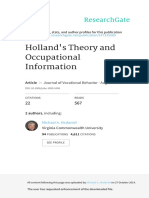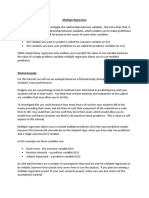Top Tips
Uploaded by
S NTop Tips
Uploaded by
S NTop Tips
A. Be clear
B. Be concise
C. Be evidence-based
D. How to create your focused, relevant CV
E. Remember the purpose
F. Target your CV
G. Using bullet points
H. What you don’t need to include
_________________
● Keep it to one or two full pages (academic CVs may be longer) - check if
there is specified page limit in the application guidance
● Use bullet points to present the information concisely
● Avoid too much context, excessive detail or unfocused material that will
dilute the impact of your most relevant messages.
__________________
Your CV is to get you the interview or meeting, NOT the job itself.
Try to address these key elements in your descriptions:
● What you were responsible for
● What you achieved
● And how you have worked within a team/with others
...so that the reader wants to learn more by meeting you.
__________________
● Target your CV to each position you are applying to – it should not be
just a list of everything that you have done
● Sometimes organisations will give guidance (on their website/recruitment
materials) on what they want you to include in your CV - if they do,
follow it.
__________________
● Provide clear evidence of your contribution and impact
● Focus on responsibilities, to showcase your skills...
● … and achievements by using numbers, percentages, and values to
quantify your impact and give a sense of scale/context.
_______________
● A well written CV is easy to read and scan quickly; clear font of 10 pt or
11 pt; some blank spaces; not too narrow a margin
● We would recommend writing your role/position and the name of the
organisation on the left-hand side of the page and the dates on the right-
hand side
● Use simple language – avoid jargon, generalisations, ‘management
speak’, and acronyms
● Do not write in prose or paragraphs – as space is limited
● CVs are usually a record of what you have done in the past, so completed
tasks and activities should be written in the past tense. If you are
describing an activity/role/job you are currently doing, the present tense is
fine.
______________
● Make a list (for yourself) of all of your experience, achievements, and key
dates, including educational achievement, work experience, prizes,
awards, involvement in societies, sports and clubs and your other interests
and skills (for example, languages and special/unusual IT skills). Note
down the key skills and attributes which led to these achievements.
● Identify the skills and competencies required for the role you are applying
to. You can do this by reading the job advertisement or job description
and by looking at the organisation’s website, publicity material and
recruitment literature. Check the relevant occupation section of our
website and see our page on demonstrating you fit the job criteria for
more advice.
● From your list, select the most relevant examples that demonstrate the
skills and competencies required for the role. Remember, you will have
gained valuable transferable skills in a broad range of activities that you
may have undertaken.
● Select the format of CV – for most student applications, the traditional
reverse chronological format is recommended. If you are unsure about
which CV type is appropriate, please ask one of our careers advisers.
Dividing your CV into sections/headings makes it easier for the reader, e.g.:
1. EDUCATION: normally at the top (especially for recent graduates
entering the jobs market for the first or second time). Include awards
under each relevant education section, for example, grant awards for a
DPhil, school prizes, undergraduate prizes or high rankings (‘2nd in
year’)
2. EXPERIENCE (rather than “Employment”): this can include voluntary
work, student society roles, internships, paid work, etc.
3. INTERESTS or COMMUNITY ACTIVITY AND SKILLS should be
included to indicate extra, diverse talents. Within this section, you might
use sub-categories such as IT Skills (but only if they are specialist or
unusual); Languages; Music; Sports; etc.
______________
Remember that the CV is meant to get you the interview/meeting, so don’t feel
you have to include every last detail – leave the reader wanting to learn more
about you. You don't need to include the following in a CV:
● The words ‘Curriculum Vitae’ or ‘CV’
● Date of birth and/or age
● Marital status, disability, children, partner, sexual preferences, sex, racial
background, religion
● Home address
● Nationality – unless you want to show that you do have the Right to Work
in the country in question
● Referees – this takes up space, they’ll assume you have them, there are
probably other opportunities to record these details
● Basic IT skills: these days everyone can use the internet, word processing,
spreadsheets, etc., to a competent level – but do include any super-
advanced qualifications in MS Office and of course any specialist
software like python, C++, SPSS, etc.
● Interests such as ‘socialising with friends, cooking, reading, cinema’ etc.
If you do choose to include them, give more details e.g.: ‘French films of
1940-1960’.
_______________
Aim to create impactful bullet points, with each bullet focused on a single idea.
Consider applying the ‘CAR’ mnemonic
● Context: the organisation name, your job title and dates is often
sufficient.
● Action Words that demonstrate you took responsibility are useful for
starting the bullet point, to highlight skills used – e.g. analysed, created,
recommended, managed or led. See our list of action words on
our Demonstrate You Fit the Job Criteria page for more.
● Results can often be linked within an individual bullet point.
You might also like
- Service Manual For Preventive Maintenance 6SE483 0303100% (1)Service Manual For Preventive Maintenance 6SE483 030355 pages
- CV Cover Letter Interview Reference Guide 1No ratings yetCV Cover Letter Interview Reference Guide 122 pages
- Effective CV Writing To Be Successful in Job Hunt & InterviewsNo ratings yetEffective CV Writing To Be Successful in Job Hunt & Interviews78 pages
- Create a winning CV and covering letter - July 2013No ratings yetCreate a winning CV and covering letter - July 201316 pages
- Open Doors For Employment .: Effective CV WritingNo ratings yetOpen Doors For Employment .: Effective CV Writing38 pages
- UGM - CV and Cover Letter Guide (Aug 22) - SharedNo ratings yetUGM - CV and Cover Letter Guide (Aug 22) - Shared41 pages
- Writing An Effective CV: Careers ServiceNo ratings yetWriting An Effective CV: Careers Service31 pages
- Building An Effective CV pb0002 - Next v2No ratings yetBuilding An Effective CV pb0002 - Next v27 pages
- What Should You Include in A CV?: Contact DetailsNo ratings yetWhat Should You Include in A CV?: Contact Details3 pages
- Your CV (Curriculum Vitae) Is The Business Card You Give To The Company Where You Are Going To Apply, Usually Combined With Your Cover LetterNo ratings yetYour CV (Curriculum Vitae) Is The Business Card You Give To The Company Where You Are Going To Apply, Usually Combined With Your Cover Letter3 pages
- Scientific Management Organisation AchievementNo ratings yetScientific Management Organisation Achievement7 pages
- LearnEnglish Business Magazine Writing A Good CVNo ratings yetLearnEnglish Business Magazine Writing A Good CV5 pages
- Preparing CV & Cover Letter: Course: ENG101 English Reading & CompositionNo ratings yetPreparing CV & Cover Letter: Course: ENG101 English Reading & Composition18 pages
- LearnEnglish Business Magazine Writing Good CVNo ratings yetLearnEnglish Business Magazine Writing Good CV5 pages
- Brief Guideline On Writing An Effective CVNo ratings yetBrief Guideline On Writing An Effective CV5 pages
- Writing A Cv: ≤∞∞Μø¥Ø±∑ Bšô« ©≤≥® Œbf« ≠ Vë - « Wm«No ratings yetWriting A Cv: ≤∞∞Μø¥Ø±∑ Bšô« ©≤≥® Œbf« ≠ Vë - « Wm«1 page
- In The Name of Allah, The Most Beneficent, The Most MercifulNo ratings yetIn The Name of Allah, The Most Beneficent, The Most Merciful20 pages
- Effective CVS: Careers Advisory ServiceNo ratings yetEffective CVS: Careers Advisory Service12 pages
- Using ChatGPT to Create the Perfect Graduate Resume: A Step-by-Step Blueprint for SuccessFrom EverandUsing ChatGPT to Create the Perfect Graduate Resume: A Step-by-Step Blueprint for SuccessNo ratings yet
- Enter Excel Flourish - Tested Ways For Sustainable Career GrowthFrom EverandEnter Excel Flourish - Tested Ways For Sustainable Career GrowthNo ratings yet
- IPOPHL Memorandum Circular No. 2022-016 Revised Implementing Rules and Regulations For Patents, Utility Models and Industrial Designs of 2022No ratings yetIPOPHL Memorandum Circular No. 2022-016 Revised Implementing Rules and Regulations For Patents, Utility Models and Industrial Designs of 202264 pages
- Hungry Bone Syndrome - StatPearls - NCBI BookshelfNo ratings yetHungry Bone Syndrome - StatPearls - NCBI Bookshelf1 page
- Surface Site Characterization For On-Site Septic SystemsNo ratings yetSurface Site Characterization For On-Site Septic Systems4 pages
- Assessment of Supervision in Public Basic Schools in Northern GhanaNo ratings yetAssessment of Supervision in Public Basic Schools in Northern Ghana19 pages
- Topic 4 - Introduction To Financial StatementNo ratings yetTopic 4 - Introduction To Financial Statement51 pages
- Name Roll Number Phone Number DepartmentNo ratings yetName Roll Number Phone Number Department18 pages
- Photoshop Brush Tool: A Basic Guide: What Is It?No ratings yetPhotoshop Brush Tool: A Basic Guide: What Is It?16 pages
- Final HDFC LIFE Sanchay Par Advantage - Sep 24 Final Badrish SirNo ratings yetFinal HDFC LIFE Sanchay Par Advantage - Sep 24 Final Badrish Sir7 pages
- XD_STPIE_20230718_1042_Truck963020_WDB9630201L757448_code 13 Initial quick test with fault freeze frame dataNo ratings yetXD_STPIE_20230718_1042_Truck963020_WDB9630201L757448_code 13 Initial quick test with fault freeze frame data26 pages
- Gri 308 Supplier Environmental Assessment 2016No ratings yetGri 308 Supplier Environmental Assessment 201610 pages
- Apznzazjrxzw87wtk2bqwognaipfravecestzarvrxvwm4btmduck5azom5o3feznffagnpzl6t3 q5jhtrkit46a5 Lriz7fvryjghawxaxpq6nrras Gljyp0y3f64tds3pwxy4u32lz778tfh5qwa8aowrjmm2fpuiyn3pb5lznzl0bl Lfo2vfl 8 Cb743m1s9mh7b18wph4odgNo ratings yetApznzazjrxzw87wtk2bqwognaipfravecestzarvrxvwm4btmduck5azom5o3feznffagnpzl6t3 q5jhtrkit46a5 Lriz7fvryjghawxaxpq6nrras Gljyp0y3f64tds3pwxy4u32lz778tfh5qwa8aowrjmm2fpuiyn3pb5lznzl0bl Lfo2vfl 8 Cb743m1s9mh7b18wph4odg7 pages
- Sdo Nueva Ecija Deped Hour On Dwne 900Khz Am Hosted by Dr. Eva Fe TaclibonNo ratings yetSdo Nueva Ecija Deped Hour On Dwne 900Khz Am Hosted by Dr. Eva Fe Taclibon4 pages
- Specification Sheet - English - AVR-X2000No ratings yetSpecification Sheet - English - AVR-X20002 pages
- Netdroid: Summarizing Network Behavior of Android Apps For Network Code MaintenanceNo ratings yetNetdroid: Summarizing Network Behavior of Android Apps For Network Code Maintenance11 pages




































